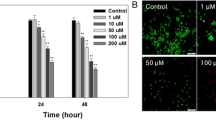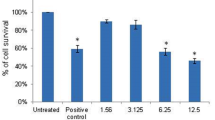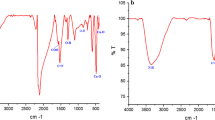Abstract
Objective
The objective of this study was to synthesize novel gold nanoparticles (Au(0)NPs) that simultaneously activates p53 and inhibits NF-kB signaling in SKBR3 breast cancer cells.
Methods
The tetracycline-based Au(0)NPs were synthesized by chemical method. These Au(0)NPs were characterized by different authentic techniques. The first characterization technique was UV–Visible (UV–Vis) spectroscopy to monitor Plasmon absorption maxima at 529 nm. The second technique was X-ray powder diffraction (XRD) pattern to confirm the crystalline nature of the prepared the Au(0)NPs. Finally, the Fourier transformed infra-red (FT-IR) spectroscopy was used to study the bonding patterns of the prepared the prepared Au(0)NPs with a size range of 10–50 nm. These Au(0)NPs were used as a nanomedicine to treat SKBR3 breast cancer cells using relative gene and protein expression studies.
Results
In response to Au(0)NPs, the level of caspases (3, 8 and 9) were changed, p53 was activated and NF-κB was inhibited simultaneously. The viability and proliferation of breast cancer cells (SKBR3) were downregulated as compared to the normal breast cells (CRL-4010). In addition, the gene and protein expressions of caspases supported the data. The inverse relationship between p53 and NFκB was found in AuNPs treated breast cancer cells.
Conclusions
The study laid down a preliminary step to employ newly synthesized AuNPs as a chemotherapeutic agent that stimulated cell death via both intrinsic and extrinsic apoptosis and inhibited the cell survival via suppressing the NFκB and recommended to have better insight.







Similar content being viewed by others
References
Sung H, Ferlay J, Siegel RL, Laversanne M, Soerjomataram I, Jemal A, Bray F (2021) Global cancer statistics 2020: GLOBOCAN estimates of incidence and mortality worldwide for 36 cancers in 185 countries. CA: A Cancer Journal for Clinicians 71(3):209–49
Nedeljković M, Damjanović A (2019) Mechanisms of chemotherapy resistance in triplenegative breast cancer—how we can rise to the challenge. Cells 8(9):957
Shameli Rajiri M, Aminsalehi M, Shahbandeh M et al (2021) Anticancer and therapeutic potential of Delonix regia extract and silver nanoparticles (AgNPs) against pancreatic (Panc-1) and breast (MCF-7) cancer cell. Toxicol Environ Health Sci 13:45–56
Shreyash N, Sonker M, Bajpai S, Tiwary SK (2021) Review of the mechanism of nanocarriers and technological developments in the field of nanoparticles for applications in cancer theragnostics. ACS Appl Bio Mater 4(3):2307–2334
Chen WH, Luo GF, Zhang XZ (2019) Recent advances in subcellular targeted cancer therapy based on functional materials. Adv Mater 31(3):1802725
Safdar M, Ozaslan M, Khailany RA, Latif S, Junejo Y, Saeed M, Al-Attar MS, Kanabe BO (2020) Synthesis, characterization and applications of a novel platinum-based nanoparticles: catalytic, antibacterial and cytotoxic studies. J Inorg Organomet Polym Mater 30(7):2430–2439
López-Barrera LD, Díaz-Torres R, Martínez-Rosas JR, Salazar AM, Rosales C, Ramírez-Noguera P (2021) Modification of proliferation and apoptosis in breast cancer cells by exposure of antioxidant nanoparticles due to modulation of the cellular redox state induced by doxorubicin exposure. Pharmaceutics 13(8):1251
Kanamori Y, Finotti A, Magno LD, Canettieri G, Tahara T, Timeus F, Greco A, Tirassa P, Gasparello J, Fino P, Di Liegro CM (2021) Enzymatic spermine metabolites induce apoptosis associated with increase of p53, caspase-3 and miR-34a in both neuroblastoma cells, SJNKP and the N-Myc-Amplified Form IMR5. Cells 10(8):1950
Piktel E, Ościłowska I, Suprewicz Ł, Depciuch J, Marcińczyk N, Chabielska E, Wolak P, Wollny T, Janion M, Parlinska-Wojtan M, Bucki R (2021) ROS-mediated apoptosis and autophagy in ovarian cancer cells treated with peanut-shaped gold nanoparticles. Int J Nanomed 16:1993
Ge W, Wang Y, Zheng S, Zhao D, Wang X, Zhang X, Hu Y (2021) Nuclear iASPP determines cell fate by selectively inhibiting either p53 or NF-κB. Cell death discovery 7(1):1
Hwang SG, Park J, Park JY, Park CH, Lee K-H et al (2012) Anti-cancer activity of a novel small molecule compound that simultaneously activates p53 and Inhibits NF-kB signaling. PLoS ONE 7(9):44259
Fadaka A, Aluko O, Awawu S, Theledi K (2021) Green Synthesis of Gold Nanoparticles using Pimenta dioica Leaves Aqueous Extract and Their Application as Photocatalyst, Antioxidant, and Antibacterial Agents. J Multidiscipl Appl Natural Sci 1(2):78–88
Arshad M, Ozaslan M, Ali HK, Safdar M, Junejo Y, Babar ME (2019) Molecular Investigation of Gold Nanoparticles Toxicity in Mice Model and p53 Activation. J Biol Sci 19:391–395
Khalaf MM, Abd El-Lateef HM, Mohamed IM, Zaki ME, Toghan A (2021) Facile synthesis of gold-nanoparticles by different capping agents and their anticancer performance against liver cancer cells. Colloid Interface Sci Commun 44:100482
Hassan SS, Solangi AR, Kazi TG, Kalhoro MS, Junejo Y, Tagar ZA, Kalwar NH (2012) Nafion stabilized ibuprofen–gold nanostructures modified screen printed electrode as arsenic (III) sensor. J Electroanal Chem 682:77–82
Ahmadian E, Dizaj SM, Rahimpour E et al (2018) Effect of silver nanoparticles in the induction of apoptosis on human hepatocellular carcinoma (HepG2) cell line. Mater Sci Eng C Mater Biol Appl 93(465–471):27
Raj K, Ezhilarasan D, Rajeshkumar S (2020) β-Sitosterol-assisted silver nanoparticles activates Nrf2 and triggers mitochondrial apoptosis via oxidative stress in human hepatocellular cancer cell line. J Biomed Mater Res A 2020(108):1899–1908
Khan MA, Singh D, Ahmad A, Siddique HR (2021). Revisiting inorganic nanoparticles as promising therapeutic agents: a paradigm shift in oncological theranostics. Eur. J. Pharmaceutical Sci. 105892
Shejawal KP, Randive DS, Bhinge SD, Bhutkar MA, Todkar SS, Mulla AS, Jadhav NR (2021) Green synthesis of silver, iron and gold nanoparticles of lycopene extracted from tomato: their characterization and cytotoxicity against COLO320DM, HT29 and Hella cell. J Mater Sci Mater Med 32(2):1–2
Uzma M, Sunayana N, Raghavendra VB, Madhu CS, Shanmuganathan R, Brindhadevi K (2020) Biogenic synthesis of gold nanoparticles using Commiphora wightii and their cytotoxic effects on breast cancer cell line (MCF-7). Process Biochem 92:269–276
Niloy MS, Shakil MS, Hossen MS, Alam M, Rosengren RJ (2021) Promise of gold nanomaterials as a lung cancer theranostic agent: a systematic review. Int Nano Lett 1:1–9
Rajendran I, Ponrasu T, Rajaram R, Suguna L (2021) The apoptotic effect of Ferulic acid-synthesized gold nanoparticles against human epidermoid carcinoma (A431) cells via activation of caspase-3 pathway. J Drug Deliv Sci Technol 63:102478
Bock FJ, Tait SW (2020) Mitochondria as multifaceted regulators of cell death. Nat Rev Mol Cell Biol 21(2):85–100
Muscari I, Adorisio S, Liberati AM, Thuy TT, Van Sung T, Cannarile L, Ayroldi E, Riccardi C, Delfino DV (2020) Bcl-xL overexpression decreases GILZ levels and inhibits glucocorticoid-induced activation of caspase-8 and caspase-3 in mouse thymocytes. J Trans Autoimmun 3:100035
Carrà G, Lingua MF, Maffeo B, Taulli R, Morotti A (2020) P53 vs NF-κB: the role of nuclear factor-kappa B in the regulation of p53 activity and vice versa. Cellular Molecular Life Sci 22:1
Liu J, Zhang C, Wang X, Hu W, Feng Z (2021) Tumor suppressor p53 cross-talks with TRIM family proteins. Genes Dis 8(4):463–474
Borrero LJ, El-Deiry WS (2021). Tumor suppressor p53: Biology, signaling pathways, and therapeutic targeting. Biochimica et Biophysica Acta (BBA)-Reviews on Cancer 188556.
Almeida A, Sánchez-Morán I, Rodríguez C (2021) Mitochondrial–nuclear p53 trafficking controls neuronal susceptibility in stroke. IUBMB Life 73(3):582–591
Merlin JP, Rupasinghe HP, Dellaire G, Murphy K (2021) Role of Dietary Antioxidants in p53-Mediated Cancer Chemoprevention and Tumor Suppression. Oxid Med Cell Longev 26:2021
King VL, Leclair NK, Coulter AM, Campellone KG (2021) The actin nucleation factors JMY and WHAMM enable a rapid Arp2/3 complex-mediated intrinsic pathway of apoptosis. PLoS Genet 17(4):e1009512
Medeiros M, Candido MF, Valera ET, Brassesco MS (2021). The multifaceted NF-kB: are there still prospects of its inhibition for clinical intervention in pediatric central nervous system tumors?. Cellular Molecular Life Sci 1–40
Kumari S, Advani D, Sharma S, Ambasta RK, Kumar P (2021). Combinatorial therapy in tumor microenvironment: Where do we stand?. Biochimica et Biophysica Acta (BBA)-Reviews on Cancer 188585.
Kumar S, Nandi A, Singh S, Regulapati R, Li N, Tobias JW, Siebel CW, Blanco MA, Klein-Szanto AJ, Lengner C, Welm AL (2021) Dll1+ quiescent tumor stem cells drive chemoresistance in breast cancer through NF-κB survival pathway. Nat Commun 12(1):1–3
Khan S, Suryavanshi M, Kaur J, Nayak D, Khurana A, Manchanda RK, Tandon C, Tandon S (2021) Stem cell therapy: A paradigm shift in breast cancer treatment. World J Stem Cells 13(7):841
Anoosh eghdami, Mahsa Amin Salehi, Mardan Babakhani, (2014) Determination of physicochemical properties of capsaicin and cytotoxic effect of capsicum extract in breast cancer (MCF7) cell line. Int J Biosci 4(8):262–268
Gottstein C et al (2013) Precise quantification of nanoparticle internalization. ACS Nano 7(6):4933–4945
Acknowledgements
The authors would like to acknowledge and thanks Gaziantep University for the logistic support of this study.
Author information
Authors and Affiliations
Corresponding author
Ethics declarations
Conflict of interest
Muhammad Safdar, Mehmet Ozaslan, Yasmeen Junejo, and Iffat Saeed Channa declare that there is no conflict of interest in this study.
Ethical approval
This article does not contain any studies with human participants or animals performed by any of the authors.
Rights and permissions
About this article
Cite this article
Safdar, M., Ozaslan, M., Junejo, Y. et al. Cytotoxic and anticancer activity of a novel synthesized tet-AuNPs simultaneously activates p53 and inhibits NF-kB signaling in SKBR3 cell line. Toxicol. Environ. Health Sci. 14, 69–76 (2022). https://doi.org/10.1007/s13530-021-00118-1
Accepted:
Published:
Issue Date:
DOI: https://doi.org/10.1007/s13530-021-00118-1




